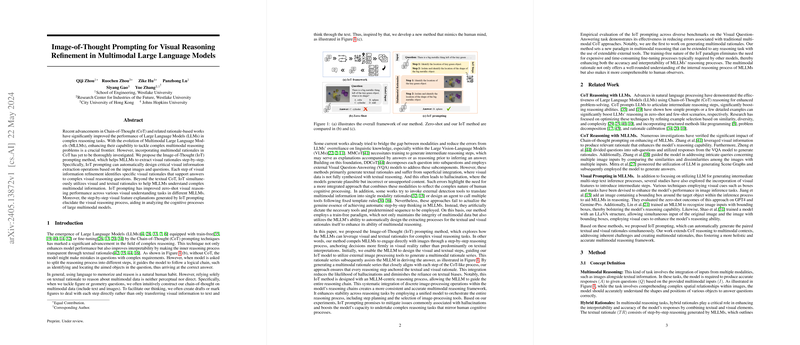Image-of-Thought Prompting for Visual Reasoning Refinement in Multimodal LLMs
The paper, "Image-of-Thought Prompting for Visual Reasoning Refinement in Multimodal LLMs" by Zhou et al., introduces a novel method termed Image-of-Thought (IoT) prompting to enhance the visual reasoning capabilities of Multimodal LLMs (MLLMs). This work addresses the challenge of integrating multimodal rationales within the framework of Chain-of-Thought (CoT) reasoning, which has proven effective in improving the reasoning performance of LLMs.
Introduction
The traditional CoT prompting techniques have advanced the complex reasoning tasks for LLMs, but there remains a limitation when dealing with multimodal data. The authors argue that solely relying on textual rationales is insufficient for tasks requiring a comprehensive understanding of multimodal inputs, such as visual and textual data. Human reasoning often involves constructing thought processes using both visual and textual cues simultaneously. Inspired by this cognitive process, the paper proposes the IoT prompting method to extract and utilize visual rationales in a step-by-step manner, enhancing the model's reasoning capacity for complex visual tasks.
Methodology
The IoT prompting method involves a structured approach to visual reasoning by:
- Action Planning and Execution: The MLLM decomposes complex questions into a series of sub-goals and selects appropriate image processing tools to perform specific visual manipulations at each step. Actions such as segmentation, object detection, geometric transformations, and spatial ruler usage are integrated into the reasoning chain.
- Hybrid Rationales Generation: For each sub-goal, the model generates both textual and visual rationales. These hybrid rationales are then concatenated to form a Multimodal Rationale Series (MRS), providing a comprehensive explanation that anchors textual reasoning in visual evidence.
- Refinement of Final Answer: The MRS is fed back into the MLLM, which refines its final answer based on the integrated multimodal rationales.
Experimental Results
The empirical evaluations demonstrate the effectiveness of IoT prompting across three benchmark datasets: MMBench, MME, and MMVet. Key findings include:
- MMBench: Significant improvements were observed in categories requiring spatial and physical reasoning. For instance, the IoT method enhanced the performance in the "Object Localization" and "Spatial Relationship" categories by notable margins for both GPT-4 and Gemini-Pro models.
- MME: IoT prompting led to enhanced performance in cognitive tasks involving commonsense reasoning, numerical calculation, and code reasoning, highlighting the model's improved capability in processing and reasoning with multimodal data.
- MMVet: The method demonstrated substantial improvements in OCR, knowledge-based reasoning, spatial awareness, and mathematical problems, indicating its robustness in diverse visual reasoning scenarios.
Implications and Future Directions
The results indicate that IoT prompting can significantly reduce modeling errors associated with traditional CoT approaches by grounding textual inferences in visual reality, thus mitigating the risk of hallucinations where models produce incorrect or unsupported content. This method leverages a train-free paradigm, which eliminates the need for expensive fine-tuning, making it a practical and scalable solution for enhancing MLLMs.
Future developments could focus on expanding the range of tools available for action planning and exploring the integration of IoT prompting in real-world applications such as robotics, where multimodal reasoning is crucial. Additionally, research could be conducted to address the limitations observed in specific categories, potentially by refining the visual rationale extraction processes to maintain high-resolution and contextually relevant information throughout the reasoning chain.
Conclusion
The IoT prompting method represents a substantial advancement in the field of multimodal reasoning for MLLMs, providing a systematic and integrated approach to combining visual and textual rationales. By aligning the reasoning process closely with how humans naturally incorporate visual and textual information, this method enhances both the accuracy and interpretability of model outputs. As MLLMs continue to evolve, techniques like IoT prompting will likely play a critical role in their ability to tackle increasingly complex and nuanced reasoning tasks.
